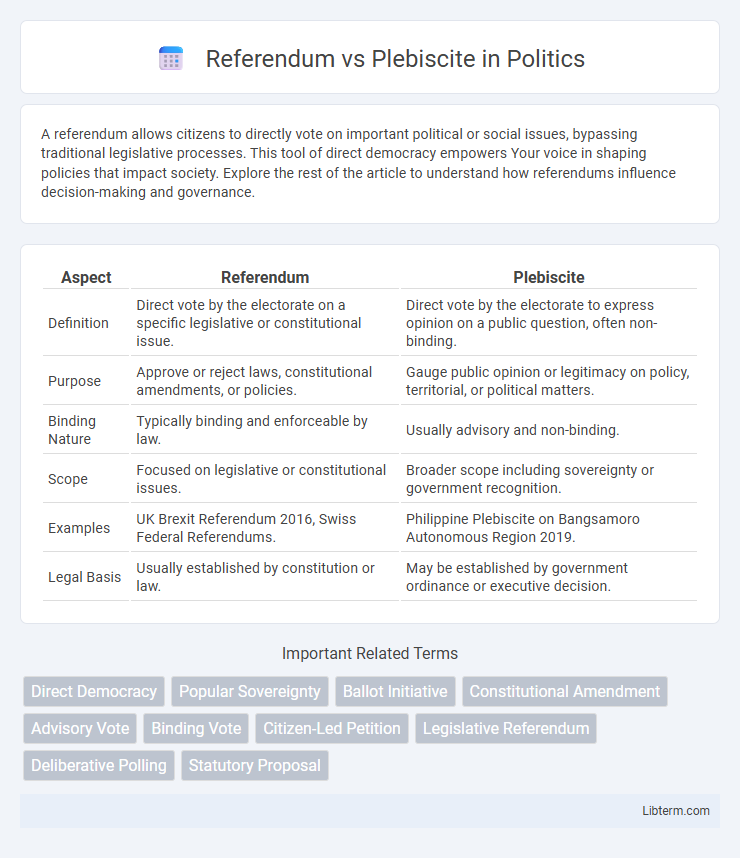A referendum allows citizens to directly vote on important political or social issues, bypassing traditional legislative processes. This tool of direct democracy empowers Your voice in shaping policies that impact society. Explore the rest of the article to understand how referendums influence decision-making and governance.
Table of Comparison
| Aspect | Referendum | Plebiscite |
|---|---|---|
| Definition | Direct vote by the electorate on a specific legislative or constitutional issue. | Direct vote by the electorate to express opinion on a public question, often non-binding. |
| Purpose | Approve or reject laws, constitutional amendments, or policies. | Gauge public opinion or legitimacy on policy, territorial, or political matters. |
| Binding Nature | Typically binding and enforceable by law. | Usually advisory and non-binding. |
| Scope | Focused on legislative or constitutional issues. | Broader scope including sovereignty or government recognition. |
| Examples | UK Brexit Referendum 2016, Swiss Federal Referendums. | Philippine Plebiscite on Bangsamoro Autonomous Region 2019. |
| Legal Basis | Usually established by constitution or law. | May be established by government ordinance or executive decision. |
Understanding Referendums and Plebiscites
Referendums and plebiscites are direct voting processes that allow citizens to decide on specific political or constitutional issues. Referendums typically involve legislative bodies posing questions to the electorate for approval or rejection of laws or amendments, while plebiscites generally seek public opinion on policy matters without legislative commitment. Understanding the distinction between these mechanisms is crucial for analyzing their legal implications and democratic significance in governance.
Historical Origins and Evolution
Referendums trace their historical origins to ancient Rome, where citizens voted directly on laws and policies, evolving into modern democratic tools for approving or rejecting legislative decisions. Plebiscites emerged in the early 19th century, particularly in Napoleonic France, as instruments for leaders to legitimize political authority through popular approval. Over time, referendums have evolved into formal mechanisms embedded in constitutional law, while plebiscites often serve as opinion polls or advisory votes without binding legal force.
Key Definitions and Distinctions
A referendum is a direct vote by the electorate on a specific legislative or constitutional issue, often binding in nature, whereas a plebiscite is typically a non-binding vote used to gauge public opinion on a political or social question. Referendums usually involve complex legal frameworks and require formal government sanction, while plebiscites are more flexible and can be advisory, serving as a consultative tool for policymakers. The primary distinction lies in the legal effect: referendums have compulsory implementation of outcomes, contrasting with plebiscites that inform decision-making without guaranteeing legislative action.
Legal Frameworks and Procedures
Referendums and plebiscites differ primarily in their legal frameworks and procedures, with referendums typically embedded in constitutional law, requiring formal legislative approval and clear legal authority for binding outcomes. Plebiscites often operate under simpler legal statutes or executive orders, functioning as consultative tools without obligatory legal consequences. Procedural distinctions include the scope of voter eligibility, question formulation, and regulatory oversight, where referendums demand rigorous compliance with electoral laws, while plebiscites allow more flexible, often advisory processes.
Political Significance and Purpose
A referendum serves as a direct democratic tool allowing citizens to approve or reject specific legislative acts, thus shaping constitutional or major policy decisions. Plebiscites primarily gauge public opinion on broader political questions, often employed by governments to legitimize authority or major political shifts without binding legal consequences. Both instruments play crucial roles in political systems by enhancing citizen participation, but referendums typically carry greater legal and constitutional significance.
Types and Examples Worldwide
Referendum and plebiscite are types of direct votes used to make decisions on specific issues; referendums typically involve proposed laws or constitutional amendments, while plebiscites often address broader policy questions or sovereignty matters. Examples of referendums include the 2016 United Kingdom Brexit vote and the 2017 Colombian peace agreement referendum, whereas notable plebiscites include Australia's 1967 nationality referendum and the 2019 New Caledonia independence plebiscite. These democratic tools vary globally in legal binding power and scope, reflecting distinct political and constitutional contexts.
Advantages and Limitations
Referendums provide citizens with direct participation in important policy decisions, enhancing democratic legitimacy and accountability, but they may be limited by low voter turnout and the complexity of issues presented. Plebiscites offer governments a tool to gauge public opinion on specific questions, often acting as advisory mechanisms, yet their results can be non-binding and subject to political manipulation. Both tools help in legitimizing decisions but require careful design to avoid oversimplification and ensure inclusive, informed participation.
Impact on Democracy and Governance
Referendums empower citizens to directly influence significant legislative decisions, reinforcing democratic participation and enhancing government accountability. Plebiscites, while also engaging the public, typically gauge opinion on non-binding issues, which can guide policymakers without mandating action. The distinction between these tools shapes governance by balancing direct democracy with representative oversight, affecting legitimacy and political stability.
Case Studies: Notable Referendums and Plebiscites
The 2014 Scottish Independence Referendum exemplifies a notable referendum where the electorate decisively voted against secession from the United Kingdom with 55% opposing independence. In contrast, the 1935 Saar status plebiscite directed voters in the Saar Basin to choose between rejoining Germany or remaining under League of Nations administration, resulting in 90% opting for reunification with Germany. These cases highlight how referendums typically address constitutional changes with binding outcomes, whereas plebiscites often serve to gauge public opinion on territorial status or policy issues.
Future Trends and Challenges
Future trends in referendum and plebiscite processes emphasize digital voting technologies and real-time stakeholder engagement to enhance transparency and accessibility. Challenges include safeguarding cybersecurity, mitigating misinformation campaigns, and ensuring equitable participation across diverse populations. Legal frameworks must evolve to address these technological advancements while maintaining the integrity and legitimacy of direct democratic decisions.
Referendum Infographic

 libterm.com
libterm.com